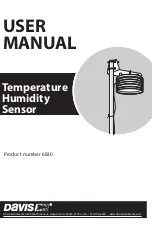
Part No. 4801-5307 Rev 2-15
Evolution 3000 and 3001
23 of 70
(1)Low Temperature Alarm Details
(2)Alarm On/Off = Off
(3)Low Temperature Limit = 71.5°
(4)Last Alarm Statistics:
(5)Date: 02/12 (5)Time: 1:09a
(6)Cause: Sensor 1
6.7.2
Low Temperature Alarm Details
The Low Temperature Alarm Details lists the settings for the alarm and the last time the alarm was sounded
and the cause of the alarm.
(1) Low Temperature Alarm Details
– Identifies
the following information:
(2) Alarm On/Off –
The status of the alarm is On or
Off.
(3) Low Temperature Limit -
The current setting of
the Low Temperature alarm limit.
(4)Last Alarm Statistics -
Identifies the date, time
and cause of the last alarm.
(5) Date & Time –
The date and time of the last alarm. Date is given as Month/Day.
(6) Cause -
Displays the reading of the low temperature that caused the alarm.
Possible Reasons for Low Temperature False Alarm Conditions
:
If the same sensor causes multiple alarms, check the location of the sensor and wiring for possible
damage. Also insure that the limit is properly set for the target and room temperature.
6.7.3
Tunnel Vent Alarm Details
The Tunnel Alarm Details shows the settings for the
alarm, the last time the alarm was sounded and the
cause of the alarm.
(1) Tunnel Alarm Details –
Identifies the following
information:
(2) Alarm On/Off
– The status of the alarm is On or
Off due to tunnel. Not settable. Status
indicator only. NOTE: This alarm is
automatically set by the Evolution 3000 or
3001 Controller.
(3) Last Alarm Statistics -
Identifies the date, time and cause of the last alarm.
(4) Date & Time -
The date and time of the last alarm.
(5) Cause
- Displays the cause of the tunnel error. The following are the problems that could cause a
Tunnel Error:
Tunnel Auxiliary
would be when the controller has seen a closed signal from the tunnel curtain
during tunnel. After 20 seconds the system will come out of tunnel and return to natural or
power ventilation.
Nat Auxiliary
would be when the controller has seen an open signal from the natural curtains
during tunnel or that the curtains never closed from natural allowing the system to go into
tunnel. This alarm would take 13 minutes from when it started to go into tunnel. After 20
seconds the system will come out of tunnel and return to natural or power ventilation.
Low Pressure
would be when the pressure fell below the low pressure alarm setting during tunnel.
This alarm will need to see the pressure below the limit for 45 seconds. At this point the
Alarm Status LED will start blinking. Then after another 20 seconds the system will come out
of tunnel and return to natural or power ventilation.
High Pressure
would be when the pressure went above the high limit alarm setting during tunnel.
This alarm will need to see the limit exceeded for 45 seconds. At this point the Alarm Status
LED will start blinking. Then after another 20 seconds the system will come out of tunnel and
return to natural or power ventilation.
Possible Reasons for Tunnel Vent Alarm Conditions
:
Tunnel Inlet failed to open.
Natural Curtain failed to close.
High Static Pressure due to lack of inlet opening.
NOTE:
Due to the nature of these errors, the control tunnel enable must be reset in order for the
control to re-enter tunnel. Be sure to check the cause if this is a reoccurring problem.
(1)Tunnel Alarm Details
(2)Alarm On/Off = Off
(3)Last Alarm Statistics:
(4)Date: 02/06 (4)Time: 1:09a
(5)Cause: Nat Auxiliary
















































